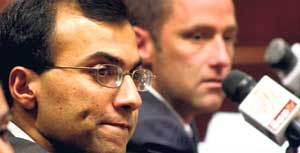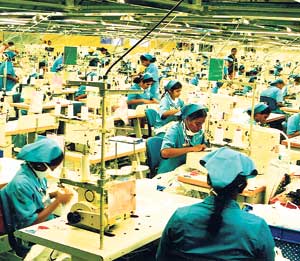This year could not have started any worse than it did for the Sri Lankan economy.
The external sector was gloomy with a global recession stifling Sri Lankan exports and foreign investors bailing out.

IMF Resident Representative
Dr. Koshy Mathai at a press briefing |
The domestic situation was worse with the war escalating into higher costs and security measures suffocating economic activities. By the end of the first quarter, the country was heading for a foreign exchange crisis.
However, after the dark clouds, the silver lining did show.
The war was officially declared as over, in May. The much delayed International Monetary Fund (IMF) loan came through in July and a foreign exchange crisis was avoided. The IMF money and the end of war buoyed investor confidence.
By October, Fitch Ratings and Standard & Poor’s had upgraded Sri Lanka’s sovereign rating from ‘negative’ to ‘stable’. International funds started taking an interest in Sri Lanka and a few actually put money in government securities. Also in October, the Colombo Stock market turnover hit the trillion rupee mark and by end-October foreign exchange reserves went over Rs 4 billion.
Meanwhile, the rupee started showing signs of appreciating instead of its usual practice of depreciating and the rate of inflation was dropping, instead of climbing, until in September, the point-to-point change fell to 0.7%.
Sri Lanka’s economic growth rate, which had slowed to a 1.5% crawl in the 1st quarter, also started picking up. The latest figures from the Department of Census and Statistics show GDP growth rate at 4.2% in the 3rd quarter and is expected to be higher in the 4th quarter. The government is anticipating a 6% GDP growth in 2010.
Big black mark
However, despite strong economic control while conducting the war (including containing the rate of inflation), the government has not been able to pass on a lower cost-of-living, as a peace dividend, to the war-weary public. This is generally seen as the biggest black mark against the government’s economic management, since the war ended.
The rate of inflation is expected to increase faster towards the end of the year and in 2010, pushing up the cost of living further next year.
GSP+ and exports to the
EU in 2010
While the global economy was in downturn and Sri Lanka lost market share in the US, the GSP+ duty free trade scheme helped Sri Lankan exporters not just retain, but even grow market share in the European Union (EU).
For instance, in the first nine months of this year incomes from garments exports to the US dropped by 13.2% but export earnings from the EU increased by 4.3%, compared to 2008.
So at this point, exporters and many potential exporters are watching GSP+ developments closely. If the GSP+ is suspended in 2010, many potential investors and existing exporters with expansion plans, may reconsider their plans.
While Sri Lanka has the option of re-applying for the GSP+ at the end of its current cycle, by end-2011, this too may not return the GSP+ unless the government can satisfy the EU on its human rights concerns. |
Working economy
Sri Lanka’s unemployment rate that was on a declining trend between 2004 – 2008 from 8.1% to 5.2%, reversed this year. The rate of unemployment climbed to 6.2% in the 2nd quarter and was 5.9% in the 3rd quarter of 2009.
To compensate for the rising cost of living, this year also saw salary increases in the public sector and some private sector areas. For instance, September 2009 saw another Collective Agreement in the plantation sector that pushed up worker wages by 40%.
However, on the positive side, the government and employers were able to avoid long-drawn-out trade union disruption of economic activity in the country.
Meanwhile, economists are warning that an aging population can reduce the speed of Sri Lanka’s post-war economic growth.
Made in Sri Lanka
Despite the global recession, worker remittances increased by 10% during January to September 2009 (US$ 2.48 billion), compared to the same period 2008 (US$ 2.24), according to the Central Bank.
Exports are also expected to perform better in the 4th quarter 2009, due to increased seasonal demand. From January to September 2009, total export earning dropped by 16.8%, compared to the same period 2008.
Import costs also reduced this year because of the large reduction in oil and fertilizer prices and lower import demand.
From January to September 2009, Sri Lanka’s import bill for petroleum products reduced by almost half (49%), compared to the same period 2008. This helped narrows the trade deficit and a current account surplus is expected in 2009 for the first time since 1977. However the lower imports in other areas, also indicate that Sri Lanka’s economic activities have slowed down.
Doing the math for 2010
The government has to meet a deficit target of 7% in 2009 under the IMF loan agreement. However, government revenues are expected to miss the original target for 2009 by Rs 127.3 billion, according to the Central Bank, due to reduced economic activities less VAT) and lower imports (less import taxes). Meanwhile the government’s recurrent expenditure alone, increased by 26% during the first 9 months of the year, compared to 2008.
The year 2010 has been designated Sri Lanka’s development year by the government, that has already started rolling out much needed infrastructure projects all over the country. The new markets, land, labour and oceans in the North and East are also expected to contribute to economic growth in 2010.
However, the public is looking for more direct economic benefits in 2010, such as lower cost of living, higher incomes, and more and better jobs, especially for young people. Unless the government can deliver on these areas Sri Lanka’s 2010 post-war economic recovery may not be as rosy as expected. |


